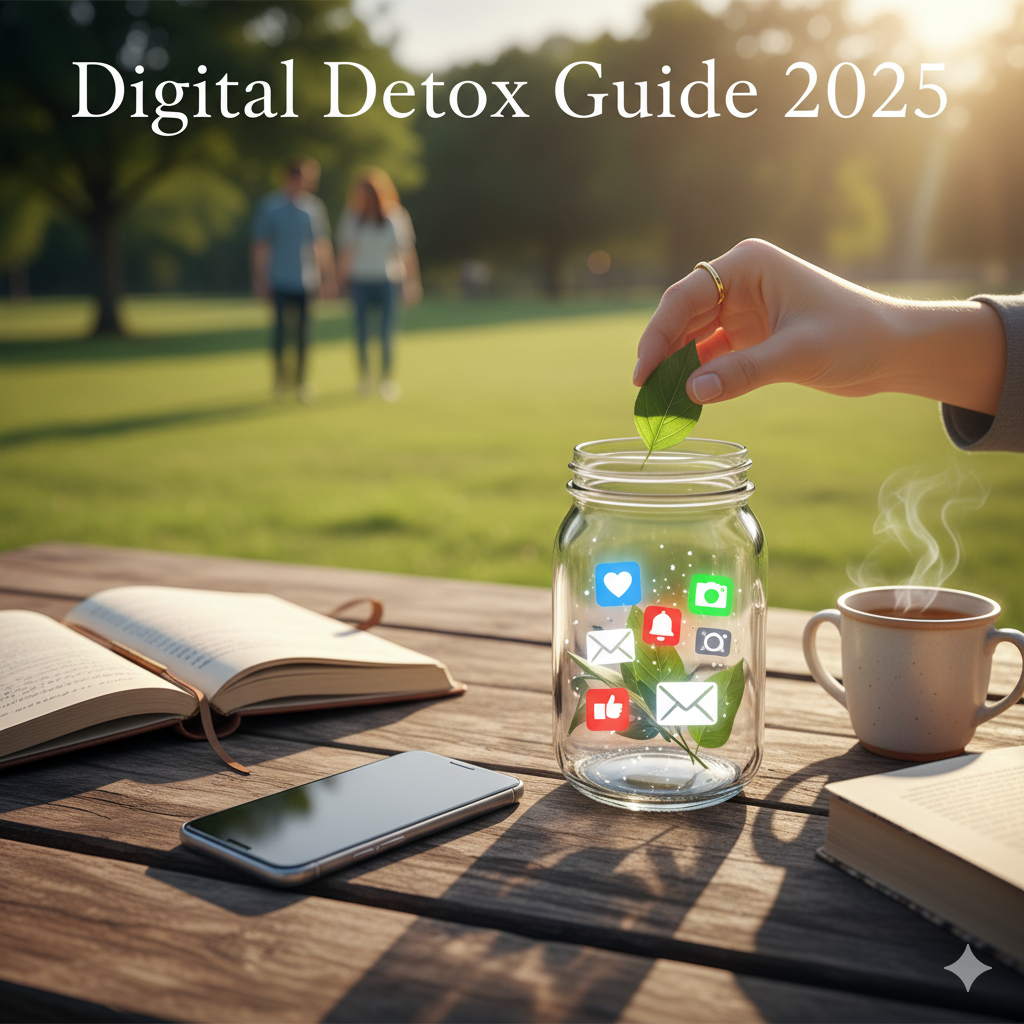Are you feeling constantly drained, distracted, and overwhelmed by the never-ending notifications and the relentless scroll? In our hyper-connected world, it’s easy to get sucked into the digital vortex, sacrificing our precious time, vital energy, and much-needed inner peace. But what if you could break free?
Imagine a life where you’re in control of your tech, not the other way around. A life where you wake up feeling refreshed, focused, and genuinely present, ready to tackle your day with clarity and calm. This isn’t a fantasy; it’s entirely achievable with a strategic digital detox.
Welcome to the Digital Detox Guide 2025 – your ultimate roadmap to unplugging intentionally, reconnecting with what truly matters, and rediscovering a more joyful, balanced you. This isn’t about ditching technology forever; it’s about building a healthier, more conscious relationship with it.
The Alarming Truth: Are You Digitally Overwhelmed?
Let’s face it: our devices are designed to be addictive. From the dopamine hit of a “like” to the fear of missing out (FOMO) that keeps us checking, tech companies employ sophisticated psychological tactics to keep us hooked.
The average person checks their phone an astounding 150 times a day. We spend hours scrolling through social media, binge-watching shows, and mindlessly consuming content – often at the expense of our sleep, relationships, hobbies, and even our mental well-being.
Symptoms of digital overwhelm are widespread:
- Constant fatigue and brain fog.
- Increased anxiety and stress.
- Difficulty concentrating and staying focused.
- Restless sleep or insomnia.
- Feelings of inadequacy or social comparison.
- Neglecting real-world relationships and activities.
If any of this resonates, don’t worry – you’re not alone, and there’s a powerful solution awaiting you.

Why a Digital Detox is More Crucial Than Ever in 2025
As technology advances, so does its integration into every facet of our lives. Smart homes, AI assistants, ubiquitous social platforms, and always-on work cultures mean that boundaries are blurring faster than ever.
In 2025, a proactive approach to managing our digital consumption isn’t a luxury; it’s a necessity for thriving. A digital detox offers:
- Improved Mental Health: Reduced anxiety, stress, and depressive symptoms.
- Enhanced Focus & Productivity: Reclaim your attention span and get more done.
- Better Sleep Quality: Blue light and constant stimulation disrupt our natural sleep cycles.
- Stronger Relationships: More present and meaningful interactions with loved ones.
- Rediscovered Hobbies & Passions: Time and energy for activities you truly enjoy.
- Increased Self-Awareness: Connect with your inner thoughts and feelings without constant distraction.
- Greater Creativity: Space for new ideas to blossom.
Ready to embark on this transformative journey? Let’s dive into the practical steps.
Step 1: The Digital Audit – Unmasking Your Habits
Before you can change your relationship with technology, you need to understand it. This step is about honest self-assessment, not judgment.
Action Plan:
- Track Your Screen Time: Most smartphones have built-in screen time trackers (e.g., “Screen Time” on iOS, “Digital Wellbeing” on Android). If not, download an app like QualityTime or RescueTime. Track for at least 3-5 days to get an accurate picture.
- Identify Your “Time Sinks”: Which apps, websites, or activities consume the most of your time? Is it social media, endless news feeds, mobile games, or streaming services? Be specific.
- Recognize Your Triggers: What prompts you to pick up your phone or open a distracting app? Is it boredom, stress, loneliness, a notification, or a specific time of day (e.g., first thing in the morning, before bed)?
- Note Your Feelings: How do you feel before, during, and after your digital consumption? Satisfied, energized, anxious, guilty, or restless?
Insight: This audit will provide a clear, often startling, overview of your current digital landscape. This awareness is your most powerful tool for change.
Step 2: Set Clear Boundaries – Drawing Your Digital Lines in the Sand
Once you know your habits, it’s time to establish rules. These boundaries act as a protective barrier around your time and attention.
Action Plan:
- Designate “No-Phone Zones”:
- Bedroom: Keep your phone out of the bedroom, especially at night. Invest in an old-fashioned alarm clock.
- Dining Table: Make meals a tech-free zone for true connection.
- Bathroom: Seriously, step away from the phone.
- Family Time/Social Gatherings: Put phones away and be present.
- Establish “No-Phone Times”:
- First Hour of the Day: Resist the urge to check your phone immediately. Use this time for meditation, exercise, journaling, or a quiet breakfast.
- Last Hour Before Bed: Wind down without blue light and stimulating content. Read a physical book, listen to music, or talk to a loved one.
- During Specific Activities: When you’re working on a creative project, exercising, or having a deep conversation, silence your phone.
- Implement Time Limits for Apps: Use your phone’s screen time settings to set daily limits for your most addictive apps. When the limit is reached, respect it.
Insight: Boundaries aren’t about deprivation; they’re about creating space for what truly nourishes you.
Step 3: Declutter Your Digital Environment – Less is More
Just like a messy physical space can create mental clutter, so too can an overloaded digital one. Simplify to amplify your focus.
Action Plan:
- Unfollow/Unsubscribe Ruthlessly: Go through your social media feeds, email subscriptions, and news alerts. Unfollow accounts that don’t inspire, educate, or entertain you positively. Unsubscribe from newsletters you never read.
- Delete Unused Apps: If you haven’t used an app in a month, delete it. If you need it later, you can always reinstall.
- Organize Your Phone/Computer:
- Homescreen Minimalism: Keep only essential apps on your main screen. Hide others in folders or app drawers.
- Turn Off Most Notifications: This is a game-changer! Only allow notifications for truly urgent communications (e.g., calls, texts from specific people). Turn off badges, banners, and sounds for everything else.
- Clean Up Your Desktop: A cluttered computer desktop reflects a cluttered mind.
Insight: A minimalist digital environment reduces temptation and makes it easier to focus on intentional usage.
Step 4: Embrace Analog Alternatives – Rediscover the Real World
The goal of a digital detox isn’t just to stop doing something; it’s to start doing something else – something more fulfilling.
Action Plan:
- Read Physical Books: Reconnect with the joy of turning pages and escaping into a story without distractions.
- Pursue a New Hobby: Pick up painting, learn an instrument, try gardening, or take up knitting.
- Spend Time in Nature: Go for walks, hikes, or simply sit in a park. Nature has a profound calming effect.
- Connect In-Person: Schedule coffee dates, dinner parties, or meet-ups with friends and family. Practice truly listening without digital interruption.
- Engage in Mindful Activities: Try meditation, yoga, or simply sitting in silence for a few minutes each day.
- Journal: Write down your thoughts, feelings, and experiences. It’s a powerful way to process emotions and gain clarity.
Insight: Filling the void left by excessive screen time with enriching analog activities is key to sustainable change and increased well-being.

Step 5: Schedule Your “Unplugged Routine” – Make It a Habit
Consistency is crucial. Just like you schedule workouts or appointments, schedule your digital breaks.
Action Plan:
- Designate Tech-Free Blocks: Block out specific times in your day or week when you commit to being completely offline. Start small (e.g., 30 minutes in the morning, an hour in the evening) and gradually increase.
- Plan Digital Detox Days/Weekends: Once you’re comfortable with shorter breaks, aim for a full day or even a weekend completely free of non-essential tech. Inform loved ones beforehand.
- Create a “Charging Station” Away from the Bedroom: Make it a habit to charge all devices in a central location, far from where you sleep. This reinforces the bedroom as a tech-free sanctuary.
- Batch Your Digital Tasks: Instead of constantly checking emails or social media, designate specific times to do so (e.g., three times a day for 15 minutes each).
Insight: Intentional scheduling transforms reactive habits into proactive choices, giving you back control.
Step 6: Mindful Consumption – When You Do Go Online, Do It With Purpose
A digital detox isn’t about complete abstinence; it’s about conscious engagement. When you do use technology, do it mindfully.
Action Plan:
- Ask “Why?”: Before you open an app or click a link, pause and ask yourself: “Why am I doing this? What is my intention?” Is it for work, to connect with a specific person, to learn something new, or simply out of habit/boredom?
- Curate Your Feeds Actively: Continually refine what you consume. Seek out content that is inspiring, informative, and genuinely beneficial. Mute or hide content that makes you feel bad.
- Engage, Don’t Just Consume: If you’re on social media, try to interact meaningfully rather than just passively scrolling. Leave thoughtful comments, send private messages.
- Use Technology as a Tool, Not a Crutch: Employ apps and devices to genuinely enhance your life, not to escape from it. For example, use a meditation app for mindfulness, or a language learning app for personal growth.
Insight: Mindful consumption transforms technology from a potential distraction into a powerful, purposeful tool.
Step 7: Practice Self-Compassion & Patience – It’s a Journey, Not a Destination
Changing deeply ingrained habits takes time, effort, and occasional slip-ups. Be kind to yourself throughout this process.
Action Plan:
- Expect and Forgive Relapses: You will inevitably slip up and find yourself mindlessly scrolling. When it happens, don’t beat yourself up. Acknowledge it, learn from it, and gently redirect yourself.
- Celebrate Small Victories: Did you make it through dinner without checking your phone? Did you resist the urge to grab your device first thing in the morning? Acknowledge and celebrate these successes.
- Find a Support System: Share your digital detox goals with a trusted friend, family member, or partner. Having someone to hold you accountable and celebrate with can make a huge difference.
- Regularly Re-evaluate: Your needs and relationship with technology will evolve. Periodically revisit these steps and adjust your boundaries and practices as needed.
Insight: Sustainable change comes from consistent effort and a compassionate understanding that building new habits is a marathon, not a sprint.
The Transformative Power of Unplugging
Embarking on a digital detox is one of the most empowering things you can do for yourself in 2025. It’s a radical act of self-care in a world constantly vying for your attention.
By taking these intentional steps, you’ll begin to experience profound shifts:
- A renewed sense of calm and clarity.
- Deeper connections with the people and world around you.
- More time and energy for your passions and personal growth.
- A heightened appreciation for the simple joys of life.
- A stronger, more resilient mind.
Your time, energy, and inner peace are invaluable. Don’t let them be silently eroded by unchecked digital habits. Reclaim them.
Conclusion: Your Journey to a More Present Life Starts Now
The Digital Detox Guide 2025 has provided you with the blueprint to transform your relationship with technology. This isn’t just about disconnecting; it’s about intelligently reconnecting – with yourself, your loved ones, and the world outside your screen.
Ready to take the first step towards a calmer, more focused, and truly present life?
Take Action Now: Pick one step from this guide – perhaps auditing your screen time or setting a “no-phone zone” in your bedroom – and implement it today. Share your journey and progress with us in the comments below or tag us on social media! Let’s build a community of conscious unpluggers.
Want more tips and resources to help you unplug and thrive? Join our Unplugged Routine newsletter for exclusive content and support delivered straight to your inbox!